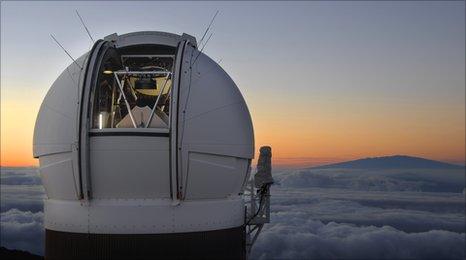Pan-Starrs telescope begins operations to hunt asteroids
- Published

The telescope is relatively small, but incorporates cutting edge technology
A new telescope facility in Hawaii designed to search for asteroids and comets which could threaten Earth has been made operational.
The Pan-STARRS 1 telescope will map large portions of the sky each night to track not only close space objects, but also exploding stars (supernovae).
The telescope has been taking science data for six months but is now operating from dusk-dawn each night.
Pan-STARRS 1 (PS1) is expected to map one-sixth of the sky every month.
The facility boasts a huge digital camera: a 1,400 megapixel (1.4 gigapixel) device that can photograph an area of the sky as large as 36 full Moons in a single exposure.
"Although modest in size, this telescope is on the cutting edge of technology," said Dr Nick Kaiser, head of the Pan-STARRS project.
The giant digital camera will take over 500 exposures each night, collecting about four terabytes of data (equivalent to what 1,000 DVDs can hold).
By casting a wide net, the telescope is expected to catch many moving objects within our Solar System.
Frequent follow-up observations will allow astronomers to track those objects and calculate their orbits, identifying any potential threats to Earth.
In January this year, a report by the US National Research Council said the country must do more to tackle the asteroid threat.
Professor Carlos Frenk, from Durham University, who is the UK's member on the Pan-STARRS board, said: "PS1 will generate the largest ever multi-colour survey of the cosmos.
"Alongside supercomputer simulations of the universe, these data will help us understand the life cycles of galaxies and, if we are very lucky, the nature of the mysterious dark matter and dark energy that control the evolution of our cosmos."
The 1.8m (60-inch) diameter telescope on Haleakala will also spot many small, faint bodies in the outer Solar System that hid from previous surveys.
PS1 is the experimental prototype for a larger telescope to be built called PS4, which will have four times the power of PS1 and is planned for Mauna Kea in Hawaii.